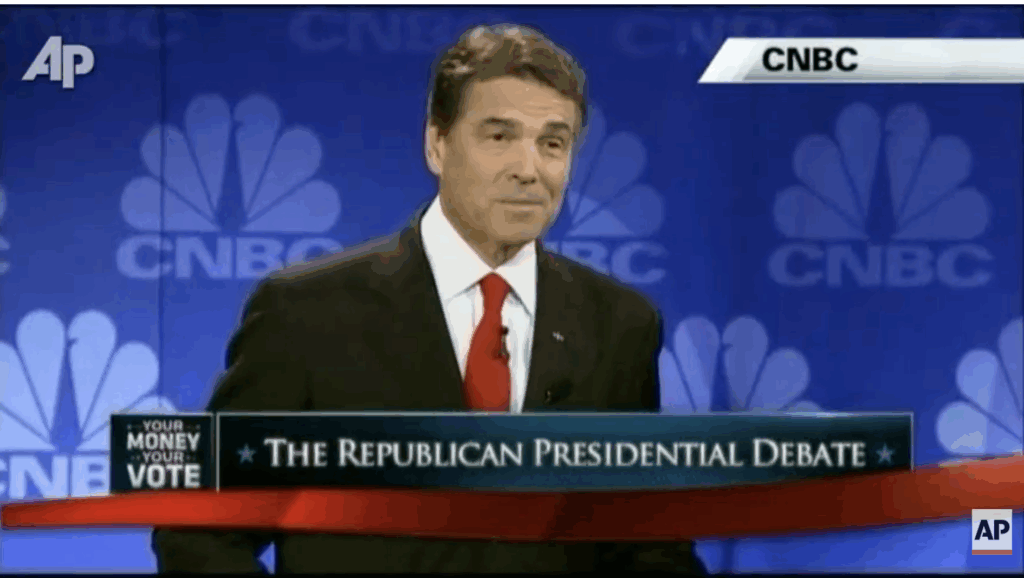Remember the 2011 Republican presidential debate when then-Texas Gov. Rick Perry blanked on one of the three federal agencies he campaigned on getting rid of if elected president? It was an unforgettable moment, particularly for Perry.
“And I will tell you, it’s three agencies of government when I get there that are gone: Commerce, Education and the, um, what’s the third one there?” he said, looking like a deer in headlights as the bright lights of the stage washed over him. He tried again. Nope.
RINO Mitt Romney tried to provide a lifeline.
“The EPA?” the former Massachusetts governor offered. Perry should have phoned a friend. “EPA, there you go,” Perry agreed, momentarily relieved. But the Environmental Protection Agency wasn’t the answer.
Perry tried one last time. “The third agency of government I would do away with — the education, the uh, the commerce and let’s see. I can’t the third one. I can’t. Sorry Oops.”

Image: The Associated Press
If you’re ever on Jeopardy! and the Painfully Embarrassing Debate Moments category comes up, the correct answer is The Department of Energy — or more in line with the game show, the question: What is the Department of Energy?
It didn’t matter. Perry faded fast and was out of the nomination chase not long after New Hampshire in January 2012. Romney went on to face far-left President Barack Obama that November. Romney lost. It was highly unlikely the Republican establishment candidate would have done much to put federal departments out of business.
More than a dozen years later, President Donald Trump — the anti-Romney — is moving as close as anyone has to slaying the bureaucratic beast that Perry struggled to remember.
‘Break Up the Federal Education Bureaucracy’
On Tuesday, the Trump administration announced it is shifting some of the department’s major programs to other federal agencies as the president continues to make good on his pledge to shut down the bloated and intrusive federal agency.
Education Secretary Linda McMahon announced six new interagency agreements with four federal agencies “to break up the federal education bureaucracy, ensure efficient delivery of funded programs, activities, and move closer to fulfilling the President’s promise to return education to the states.”
Among the responsibility transfers, the U.S. Department of Labor will take over programs within the Office of Elementary and Secondary Education, as well as some postsecondary operations. The Department of the Interior will assume Education Department programs related to Native American education. And the Department of Health and Human Services and the State Department will take on other education-related and accreditation programs currently handled by the education bureaucracy.
Secretary of Labor Lori Chavez-DeRemer said the Labor Department will focus on preparing K-12 and postsecondary education students for the workforce demands of the future.
“Parents and community leaders understand how important training and education are for students from all walks of life to succeed and support their local economies,” she said in the interagency press release. “Secretary McMahon and I will continue advancing President Trump’s vision to deliver effective, streamlined resources, so every student has a clear pathway from education to opportunity.”
Along those lines, the Labor Department will take on a greater role in administering most postsecondary education grant programs authorized under the Higher Education Act.
The Department of the Interior will take a greater role in administering education programs for Native American students — from elementary schools to higher education and career and technical schools. A report from the National Conference of State Legislatures described the state of the nation’s K-12 schools for Native Americans students as “distressing.” American Indian/Alaska Native students perform two to three grade level below white peers, and are 237 percent more likely to drop out of school, according to the report.
“Under President Donald Trump, Native American education programs will become stronger, more accountable, and fully dedicated to ensuring Native students are prepared for success,” Interior Secretary Doug Bergum said in the joint press release.
The reorganization plan doesn’t yet make any changes to the department’s management of a $1.6 million student loan portfolio and federal funds for students with disabilities. The Department’s Office of Civil Rights, which was politically weaponized under the Obama and Biden administrations, will remain in place for now.
Nonessential Agency
The latest moves build on the administration’s previous actions to dismantle the nearly $190 billion department.
In March, Trump signed executive orders directing McMahon to take all necessary steps, “to the maximum extent appropriate and permitted by law, to close the Department of Education and return more control over education to the states. Trump also directed the department to lay off 1,300 employees, nearly half of its workforce. The job cuts sparked immediate lawsuits and ultimately injunctions, but the Supreme Court in July issued an emergency ruling that cleared the way for the administration to move ahead with its workforce reduction plans.
McMahon said the recent Democrat-led shutdown, the longest shutdown in the federal government’s history, further opened her eyes to just how unnecessary the 45-year-old Education Department is. The shutdown, she said, proved the nation’s schools don’t depend on Washington bureaucracy to function.
“The Democrats kept the government shut down for 43 days. Flights were delayed, SNAP benefits ran dry, small business and housing loans were frozen, but one major component of life for American families went virtually unaffected — education,” the secretary said Tuesday in an X post. “The federal Department of Education furloughed 90 percent of its staff and what happened? Nothing. Schools stayed open, students went to class, teachers got paid.”
‘The Right Direction’
Jeanne Allen, founder and CEO of the Center for Education Reform, said Tuesday’s move is exactly what Trump promised he would do: disrupt a federal system that hasn’t worked for students in decades. Allen said the reorganization won’t be seamless and it will require clear communication between agencies, but shifting power closer to communities “is the right direction.”
“This Administration made clear from the outset that it intended to streamline—or sideline—a Department that had grown into a compliance-heavy bureaucracy rather than a catalyst for educational excellence,” the education reformer said in a statement. “For decades, the Department of Education has issued layers of rules, guidance, and red tape that burden schools instead of supporting them.”
Of course, none of the executive branch changes will matter if the Republican-controlled congress can’t move the actions into law. Lawmakers will have to pass bills codifying Trump’s executive orders to keep them alive. Executive orders, as we’ve learned over the last quarter century, can come and go with each presidential election.
Big Government defenders not surprisingly blasted the further erosion of the Education Department’s power.
Rachel Gittleman, president of the American Federation of Government, told the Associated Press that the other agencies aren’t “equipped or positioned to provide the same support and services as ED staff.” She warned that the reorganization will weaken the “national mission” of supporting schools.
That’s the idea. The educational mission shouldn’t be national in nature, McMahon asserts. Especially when the department that leads it has proved itself unnecessary.
“If 90 percent of an agency supposedly governing can disappear for weeks without disrupting education, do we really need it at all?” The secretary said.
Matt Kittle is a senior elections correspondent for The Federalist. An award-winning investigative reporter and 30-year veteran of print, broadcast, and online journalism, Kittle previously served as the executive director of Empower Wisconsin.
















